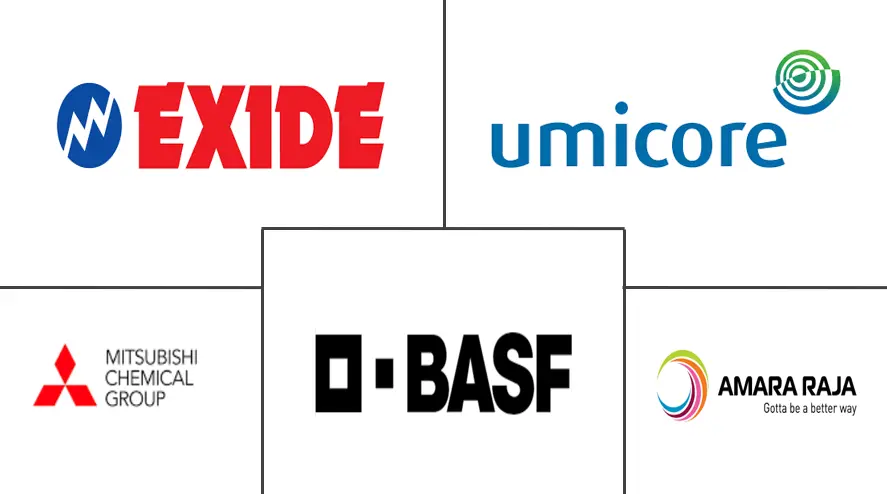India Electric Vehicle Battery Materials Market Size and Share
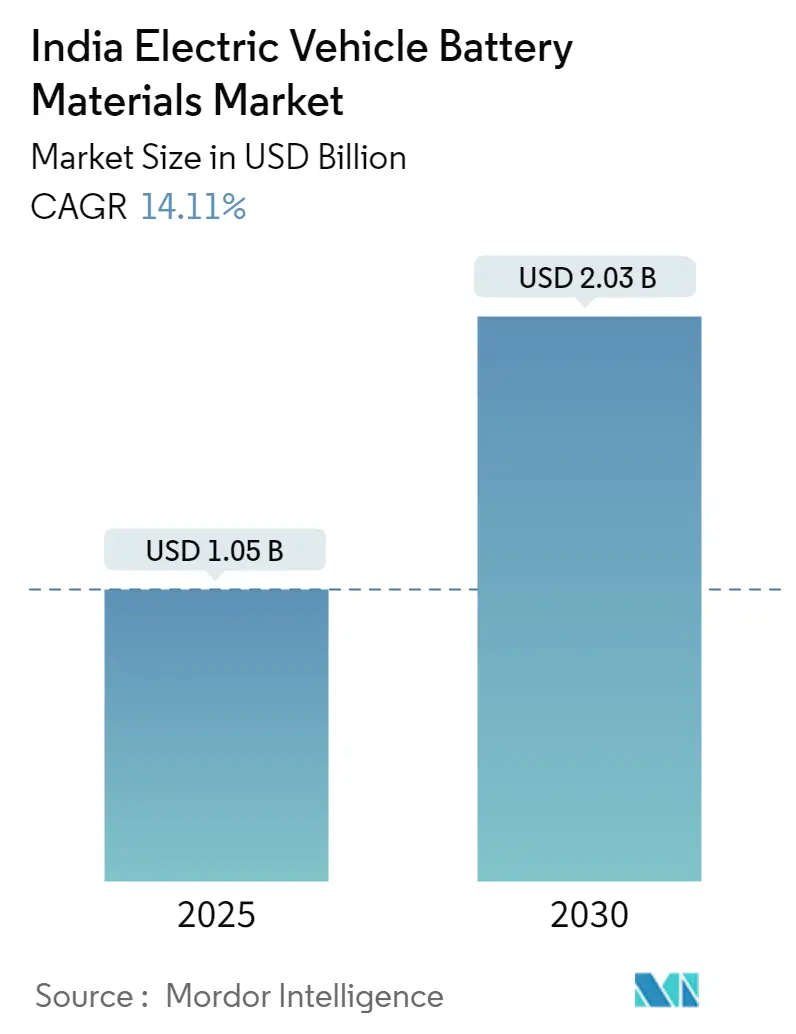
India Electric Vehicle Battery Materials Market Analysis by Mordor Intelligence
The India Electric Vehicle Battery Materials Market size is estimated at USD 1.05 billion in 2025, and is expected to reach USD 2.03 billion by 2030, at a CAGR of 14.11% during the forecast period (2025-2030).
- Over the long term, factors such as growing electric vehicle sales and supportive government policies and regulations are expected to be among the most significant drivers for the India Electric Vehicle Battery Materials Market during the forecast period.
- On the other hand, high competition from the conventional vehicle market is expected to have a negative impact on EV battery sales in India.
- Nevertheless, there is continued growing demand for Advancements in Battery Technology. This factor is expected to create several opportunities for the market in the future.
India Electric Vehicle Battery Materials Market Trends and Insights
Lithium-ion Battery Type to Dominate the Market
- The global lithium-ion electric vehicle battery market is a dynamic arena, teeming with both opportunities and challenges. Lithium-ion rechargeable batteries are outpacing other technologies in popularity, due to their superior capacity-to-weight ratio. Their adoption is further fueled by advantages like extended lifespan, minimal maintenance, enhanced shelf life, and declining prices.
- In recent years, the allure of lithium-ion batteries and cell packs has intensified for end-user industries, primarily due to falling prices. After a brief uptick in 2022, battery prices resumed their downward trajectory in 2023. A significant highlight was the 14% drop in lithium-ion battery pack prices, reaching a record low of USD 139/kWh.
- Moreover, in response to escalating environmental concerns, Indian governments are fervently championing electric vehicles. With a keen eye on net-zero carbon emission goals, the focus is clear. Lithium, a cornerstone element for EV storage capacity, is being actively extracted by leading companies in India to meet the surging demand for lithium-ion batteries.
- In a notable move, Lohum, a frontrunner in eco-friendly battery materials and lithium-ion battery recycling, announced plans in February 2024 to recycle 20GWh of scrap lithium-ion batteries between 2024 and 2030. This initiative not only underscores Lohum's commitment to sustainability but also positions the country to bolster its lithium extraction efforts through recycling.
- Furthermore, the Indian government is rolling out a suite of policies and incentives to champion electric vehicles. Measures like subsidies, financial backing, and tax rebates are significantly bolstering the demand for lithium-ion batteries across the nation.
- In a strategic collaboration, C4V, a United States based leader in Li-Ion battery technology, inked a Memorandum of Understanding (MOU) in December 2023 with Hindalco Industries. This partnership focuses on producing and supplying battery-grade aluminum foils, coated foils, and structural components for Li-ion cells, specifically targeting the burgeoning EV battery materials market in India. This alignment not only addresses the escalating demand but also underscores the significance of local manufacturing and expertise in the evolving Indian EV landscape.
- Given these developments, the lithium-ion battery material industry is poised for positive momentum during the forecast period.
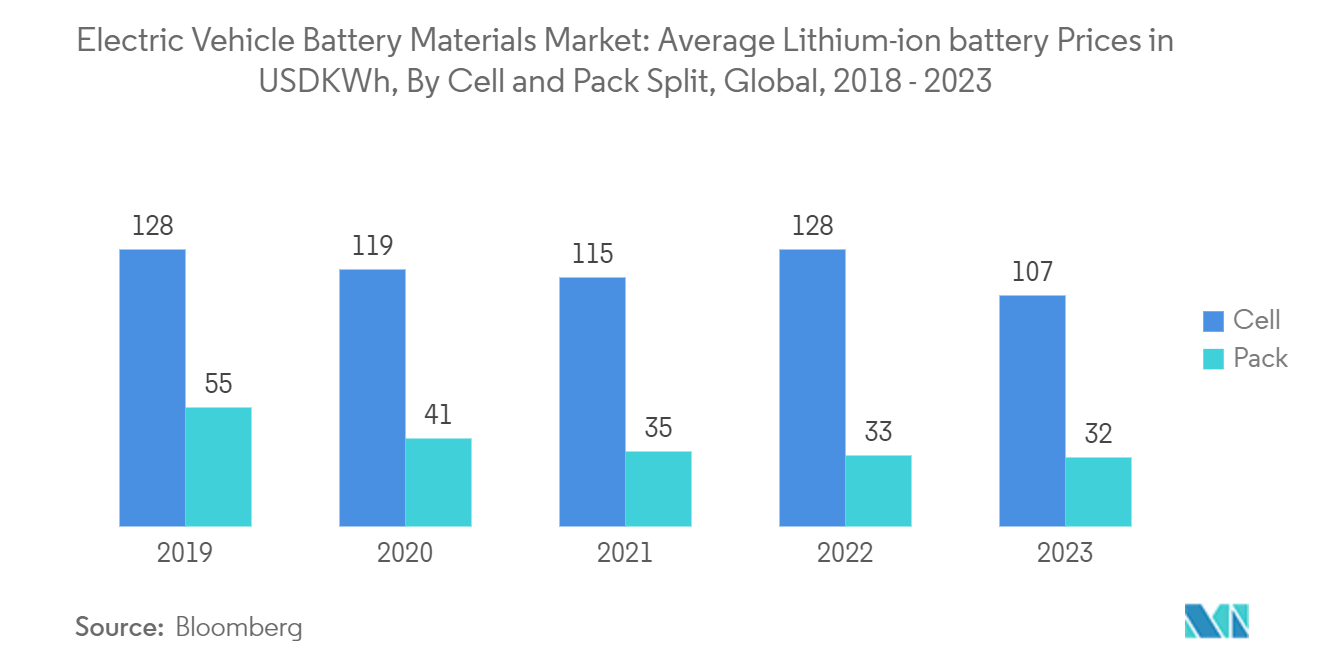
Growing Electric Vehicle Sales
- India's burgeoning electric vehicle (EV) sales are propelling the growth of the EV battery materials market. This upswing is driven by a confluence of factors: government incentives, technological breakthroughs, heightened environmental consciousness, and strategic investments from industry players.
- Data from the International Energy Agency reveals a dramatic rise in India's EV population, soaring from 3,100 units in 2020 to approximately 82,000 units in 2023. With supportive policies and initiatives, this upward trajectory is set to continue in the coming years.
- The Indian government is at the forefront of championing EV adoption, rolling out a slew of policies and incentives. The Faster Adoption and Manufacturing of Hybrid and Electric Vehicles (FAME) scheme, now in its second phase, has been instrumental, offering generous subsidies for EV purchases and bolstering the development of charging infrastructure. Furthermore, the government's ambitious target of having 30% of all vehicles on the road be electric by 2030 acts as a catalyst, propelling market growth.
- Technological strides, especially in lithium-ion batteries, have rendered EVs increasingly appealing to consumers. Key enhancements, such as improved energy density, reduced charging times, and extended battery lifespan, are pivotal in driving EV adoption. These advancements hinge on a consistent and growing supply of essential materials like lithium, nickel, cobalt, and manganese, thereby influencing the battery materials market.
- Heightened environmental concerns and a surge in consumer awareness about EV benefits are pivotal drivers. The detrimental impacts of air pollution, coupled with a global shift towards sustainable energy solutions, position EVs as a compelling alternative to conventional internal combustion engine vehicles. As consumer preference tilts towards EVs, the demand for battery materials surges correspondingly.
- Leading automotive and tech giants are pouring substantial investments into the EV arena. Tata Motors, a frontrunner in India's automotive landscape, is channeling significant resources into EV production and infrastructure. Concurrently, Exide Industries and Amara Raja Batteries are not only ramping up their production capabilities but also delving into innovative battery technologies to cater to the escalating demand.
- Highlighting the industry's aggressive expansion, August 2023 saw Ola Electric unveil its latest electric scooters, while Hyundai Motor India secured General Motors' Talegaon plant, underscoring its commitment to EV production.
- Consequently, there's been a marked uptick in the demand for materials pivotal to electric vehicle batteries, crucial for fortifying the electric mobility infrastructure. India is diligently nurturing an ecosystem to elevate its electric vehicle sector, evident from its initiatives in setting up manufacturing units, establishing research hubs, and rolling out an extensive charging network.
- Given these dynamics, the forecast period promises a robust surge in electric vehicle sales.
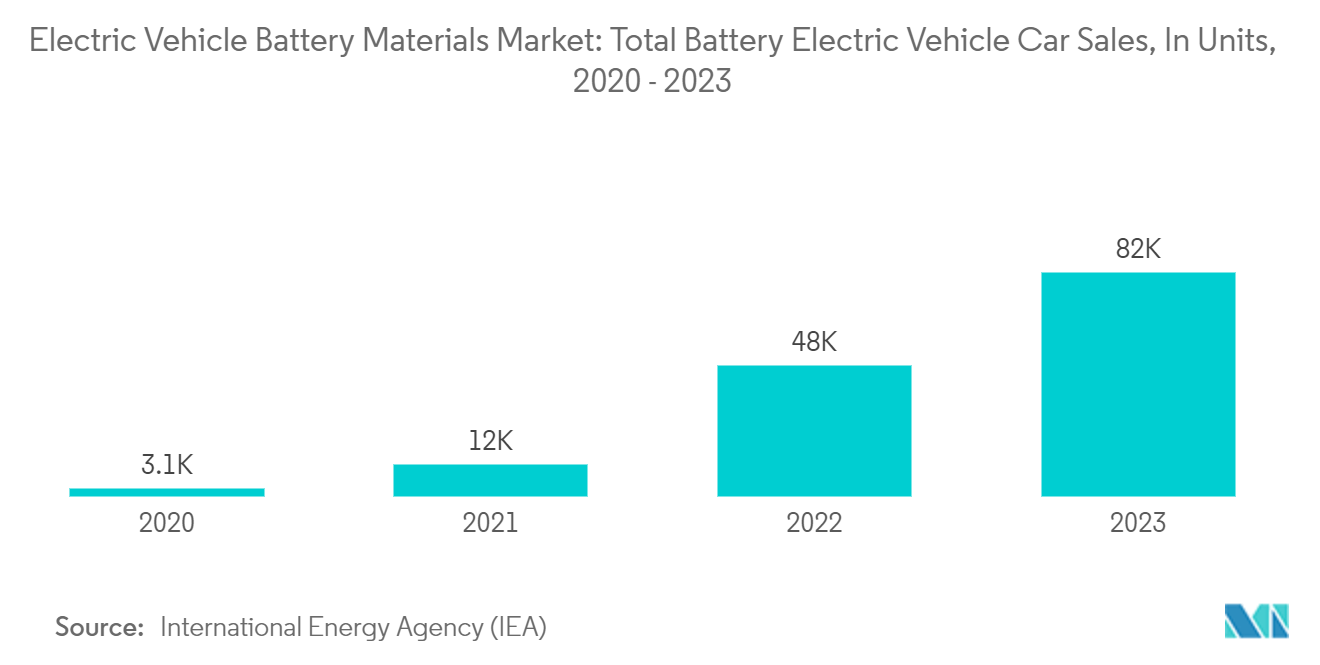
Competitive Landscape
The India Electric Vehicle Battery Materials Market is semi-fragmented. Some of the key players in this market (in no particular order) are BASF SE, Mitsubishi Chemical Group Corporation, Umicore, Sumitomo Chemical Co. Ltd., and Exide Industries.
India Electric Vehicle Battery Materials Industry Leaders
-
BASF SE
-
Mitsubishi Chemical Group Corporation
-
UBE Corporation
-
Umicore
-
Sumitomo Chemical Co. Ltd.,
- *Disclaimer: Major Players sorted in no particular order
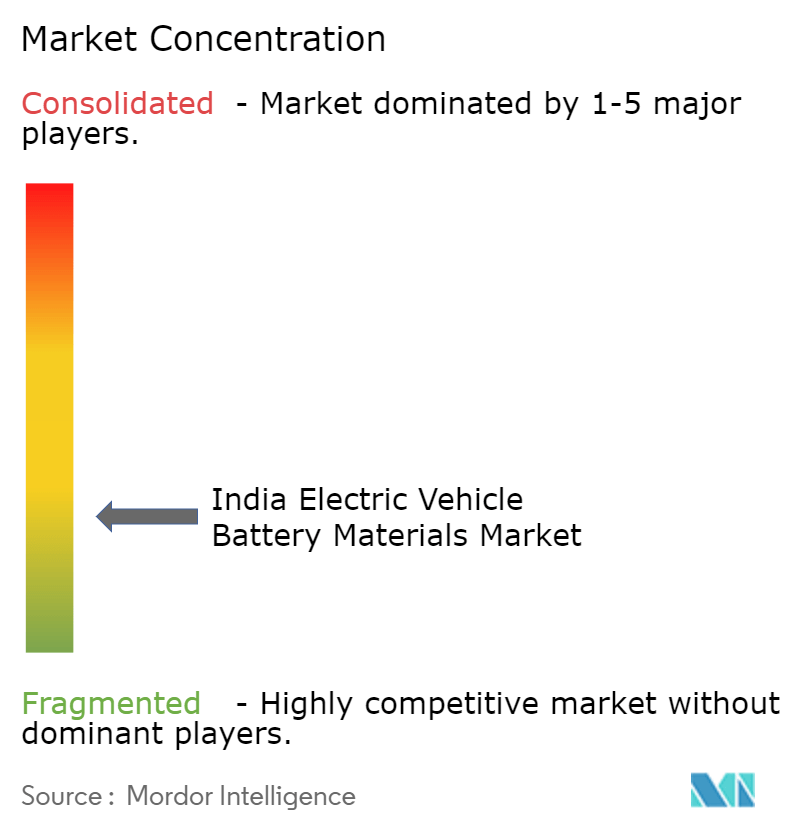
Recent Industry Developments
- February 2024: Hindalco Industries planned to invest INR 800 crore (~USD 96.4 million) to build a new aluminum foil plant near Sambalpur in Odisha, India. The facility aims to produce high-quality battery foil for the rapidly growing electric vehicle and energy storage system markets.
- January 2024: Indian companies such as Aether Industries, Himadri Speciality Chemicals, and Tata Chemicals invested in lithium-ion battery production. Aether Industries has recently announced a strategic agreement with a global lithium-ion battery producer to expand into the electrolyte additives market. This agreement includes the commercial supply of one electrolyte additive, and discussions have begun to develop three additional products. Himadri Speciality Chemicals is also planning to establish a manufacturing facility for lithium-ion battery components with a total capacity of 2 lakh tonnes per annum. Ami Organics has signed a non-binding MoU with a global manufacturer of electrolytes. The company is also set to sign an MoU with the Gujarat government to set up a dedicated manufacturing facility at a cost of around USD 36 million.
India Electric Vehicle Battery Materials Market Report Scope
- The electric vehicle (EV) battery materials are poised for significant growth, driven by the increasing adoption of electric vehicles and supportive government policies. The market primarily revolves around key materials such as lithium, nickel, cobalt, and manganese, essential for manufacturing lithium-ion batteries, which dominate the EV sector due to their high energy density and performance. Major companies are investing in R&D to enhance battery efficiency and reduce costs. Additionally, the push for domestic manufacturing and recycling initiatives is expected to bolster the market's expansion, ensuring a steady supply of critical raw materials.
- The India Electric Vehicle Battery Materials market is Segmented by Battery Type and Material. By battery type, the market is segmented into Lithium-Ion Battery, Lead-Acid Battery, and Others, and By Material, the market is segmented into Cathode, Anode, Electrolyte, Separator, and Others. The report also covers the market size and forecasts for the India Electric Vehicle Battery Materials market across the country. The Report Offers the Market Size and Forecasts in Revenue (USD) for all the Above.
| Lithium-ion Battery |
| Lead-Acid Battery |
| Others |
| Cathode |
| Anode |
| Electrolyte |
| Separator |
| Others |
| Battery Type | Lithium-ion Battery |
| Lead-Acid Battery | |
| Others | |
| Material | Cathode |
| Anode | |
| Electrolyte | |
| Separator | |
| Others |
Key Questions Answered in the Report
How big is the India Electric Vehicle Battery Materials Market?
The India Electric Vehicle Battery Materials Market size is expected to reach USD 1.05 billion in 2025 and grow at a CAGR of 14.11% to reach USD 2.03 billion by 2030.
What is the current India Electric Vehicle Battery Materials Market size?
In 2025, the India Electric Vehicle Battery Materials Market size is expected to reach USD 1.05 billion.
Who are the key players in India Electric Vehicle Battery Materials Market?
BASF SE, Mitsubishi Chemical Group Corporation, UBE Corporation, Umicore and Sumitomo Chemical Co. Ltd., are the major companies operating in the India Electric Vehicle Battery Materials Market.
What years does this India Electric Vehicle Battery Materials Market cover, and what was the market size in 2024?
In 2024, the India Electric Vehicle Battery Materials Market size was estimated at USD 0.90 billion. The report covers the India Electric Vehicle Battery Materials Market historical market size for years: 2019, 2020, 2021, 2022, 2023 and 2024. The report also forecasts the India Electric Vehicle Battery Materials Market size for years: 2025, 2026, 2027, 2028, 2029 and 2030.
Page last updated on:
India Electric Vehicle Battery Materials Market Report
Statistics for the 2025 India Electric Vehicle Battery Materials market share, size and revenue growth rate, created by Mordor Intelligence™ Industry Reports. India Electric Vehicle Battery Materials analysis includes a market forecast outlook for 2025 to 2030 and historical overview. Get a sample of this industry analysis as a free report PDF download.
